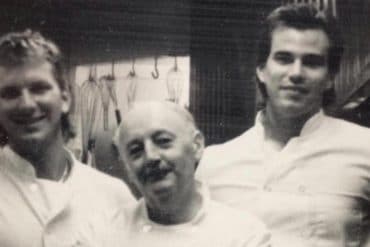WRITTEN BY PIPPIN AUSTIN
PHOTOGRAPHY BY KATIE KAIZER

SOME CALL IT THE LANDFILL, OTHERS THE RECYCLING FACILITY, but for most of us, in pick-ups and minivans loaded up with mandatory transparent bags on a Sunday morning with a cup ‘o Joe, it will always and forever be: The Dump. And the women who run the place—Patty, Nettie, Cathy, Laurie, and Carol—are its gatekeepers. Their gentle mantra: Household on the right, mixed on the left. Cardboard and cans down there. “I call it La Dump-ay,” year-rounder Geoffrey Morrell explains. “These women offer guidance and take abuse with a spirit that makes me want to come here even when I don’t have the trash to bother.” For others, going to the dump may feel like going to the dentist, but it is a job that has to be done.
“I love my job!” says Nettie Nottingham, who dumped nursing 15 years ago to work at the dump because, “I find this sort of trash much easier than blood and guts!” She’s standing at the Sort Station, where household trash is separated. Behind her a massive conveyer belt churns an infinite river of plastic bottles, crumpled cardboard, cat food and tuna tins. Even a couple of old truck tires are waiting for her to pluck and toss into the recycle bins, the green destination that had been ignored by its previous owner. Pointing down at the floor, a dense layer of odiferous mush, she explains, “That’s the point. Paper, cotton balls, milk cartons, eggshells— it all gets turned into compost.” She picks up the seat and handlebars of a kid’s tricycle, shaking her head, “What part of the word ‘recycle’ don’t people understand?”
Nettie admits to the occasional bad day: “A little while ago someone dumped a 5 gallon plastic container of…something unmentionable.” She holds her nose, and grimaces at the memory, “But I feel so good about straightening out what the ‘sneaks’ do.” The meaning of “sneaks” is obvious: Recycling scofflaws. She liberally calculates that fifty percent of dump customers are sneaks, and some habits die hard. Very few bags of household trash don’t contain at least one plastic or glass item that “accidentally” finds its way inside.
Past Nettie’s sorting and crushing warehouse is a small booth referred to as The Scale. Standing inside, fifty-one-year-old, blue-eyed blonde Laurie Clabaugh says she regularly has to wage a P.R. campaign to justify dump fees above and beyond basic household recyclables. It’s an inflationary reality, part of the cost of building the Nantucket dream. “Lots of people say, ‘But, I pay taxes, why do I have to pay to use the dump?’” The short answer is C&D: Construction and Demolition. Everything that goes into those ubiquitous green dumpsters that sprout next to each building project has a price, and it ain’t cheap. At $3.25 per 20 pounds, minus truck weight, this can add up to a hefty bill for the new homeowner doing even a modest a teardown on Cliff Road. But The Scale also offers unexpected treasures. Laurie turns to a functional 42 inch flat screen T.V. inside her booth. A large collection of discarded appliances waits on the curb besides the scale. There are no guarantees of treasures, but no price tags either. “I am so going to work with you if you’re looking for a functional appliance,” she explains with a grin, “and for free!” Peering out the window of her tiny house at an enormous commercial hauler entering the scale, she jots down the weight then waves the driver through. “Everyone knows the line: One man’s trash is another man’s treasure. Not everyone who comes here gets that point.”
Inside the sorting shed, Nettie and Laurie admit to an advantage of working behind the scenes. Bottles and cans rarely complain. It’s Cathy, Patty, and Carol, however, who make up the public face of the dump. They patrol the loading dock, the windblown oasis where all household/ glass/cardboard/plastic/tin or batteries are hopefully tossed into separate bins, in theory. But there is theory, and then there are the Sneaks. “Tut-tut-tut,” Cathy calls out to a guy poised to chuck his clear plastic bag into household. “Is that plumbing in there, Hon?” “Um….thanks. Uh, I forgot,” the man sheepishly apologizes, stooping to untie his bag, revealing the telltale glint of copper. Cathy watches him separate his trash. The man is cooperative and genuinely contrite. But in their fifteen years of working the frontlines, the trio have been attacked and insulted, and generally demeaned just for doing their job. Cathy was once even hit on the head with a piece of iron pipe she ferreted out of a household bag. Working at the dump can also have its privileges and unexpected pleasures. “One day a man came to me asking where to put his ice box. I assumed Freon to be the issue,” says fifteen-year veteran Patty Hill. “After a long discussion it became clear he was talking about an early 20th-century antique that held a block of ice. I hooked him up with an antique dealer. Later he handed me a $200 dollar tip.”
Carol Driscoll is in charge of the Take-It-Or-Leave-It building, the Filenes Basement of the landfill boasting an eclectic depository of cast-off furniture, clothes, books, shoes, appliances and amazingly diverse brick-a-brac too good or too expensive to toss into the C&D pile. For many islanders, a side trip to what’s become affectionately known as “The Madaket Mall” is like the cookie after eating your spinach. Carol is standing with local picker Mark Palmer. He holds up a hand-written love letter, framed in gold leaf, an ancient paean to some long-forgotten romance. “It’s so human to find this in the trash heap,” he laughs. “Hey, nice frame for free.”
At high noon, as the big white gates are being latched for the day, Cathy opens the door of her warming hut and retrieves a package of Ritz crackers. On cue, two seagulls instantly swoop in, and eat directly from her hand. They have names, Peg and Charlie, and are as regular as the big rig drivers who each day ferry the tons of refuse that nobody wants. Peg is one-legged. Charlie is blind. Cathy smiles, and reaches for a broom. It’s been a long day, but tomorrow it all begins again.







